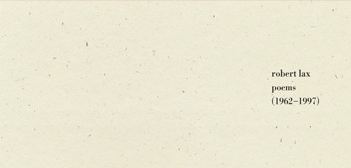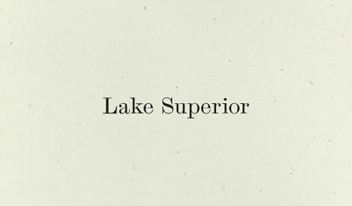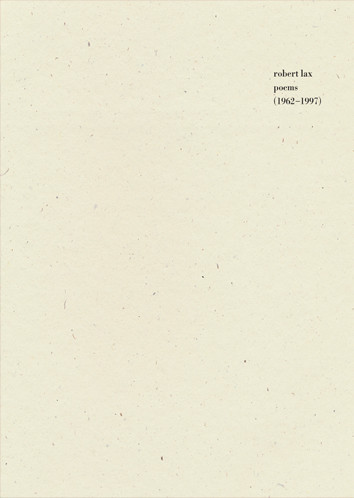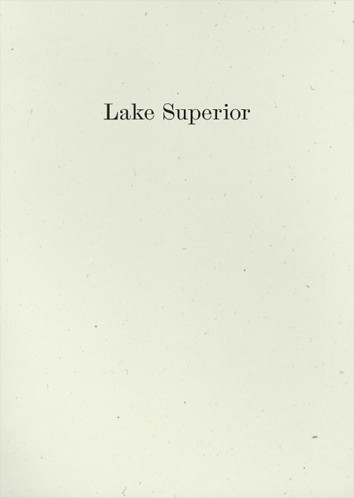But Lax has for too long been a cult figure; his originality and significance insufficiently recognized. If justice is poetic, Beer’s selection will do something to rectify this. —David Wojahn
§
Lake Superior reminds us that the creative process is one that combines learning with mental collage-making, serendipity, immense seriousness of purpose, happy accidents along with unhappy dead-ends, flashes of insight, and a willingness to fashion from the quotidian a haunted but enduring knowledge —David Wojahn
Lorine Niedecker was once called the Emily Dickinson of the Twentieth Century, and Robert Lax was known as the hermit poet. David Wojahn, who himself was a finalist for the Pulitzer Prize in 2007 and, in an earlier time, won the Yale Series of Younger Poets prize for his book of poems Icehouse Lights, pens here a special guest review essay, which begins as a paen to Wave Books, fast aligning itself with the great old independent presses like New Directions and Grove, and then considers the lives and works Lax and Niedecker. Wojahn has read long and thought deeply; it’s terrifically bracing to absorb his fluency with poets and traditions, the ease with which he epitomizes lives, works and influences. Such brevity and compression only comes with the profound familiarity and respect. I don’t think it takes a poet to read a poet, but Wojahn makes a good case.
dg
Poems 1962-1997
Robert Lax
Edited by John Beer
Wave Books
Paper, 400 pp., $25.00
Lake Superior
Lorine Niedecker
Wave Books
Paper, 91 pp., $16.00
Over the past several years, Wave Books has carved out a special niche for itself among independent presses, one that brings to mind—on a smaller scale—the role played by the great vanguard presses of the ‘50s and ‘60s, New Directions and Grove. These presses not only published some of the finest “non-mainstream” writers of the era—New Directions’ list included, among others, Robert Duncan, Denise Levertov, Stevie Smith, and George Oppen—but they were also adamant in their desire to introduce American readers to important modernist writers in translation, and unjustly neglected works (sometimes semi-scandalous ones) by figures in the tradition. Thus Grove’s list included all of Beckett’s important drama and fiction, the first credible English translation of Garcia-Lorca’s surrealist masterwork, Poet in New York, the 18th century’s wonderfully campy and salacious proto-Gothic novel, Matthew Lewis’ The Monk (this with an introduction by John Berryman), and Frank O’Hara’s legendary Meditations in an Emergency.
It was not just their discerning eclecticism that made New Directions and Grove great publishing houses; it was also the fact that the offerings of both presses had a look. New Directions titles favored eerily murky covers—the jacket descriptions as often as not printed in white ink against black backgrounds—and photos of often unrecognizable objects that looked vaguely cubist. When you looked at the cover of a book such as the New Direction translation of Sartre’s Nausea—with its badly superimposed photos of two hipster-ish men who seemed to be suffering from the effects of arsenic poisoning—even the uninitiated reader could tell that angst and dread were likely to ooze from every page. New Directions books seemed designed for two purposes—they wanted to make you take the book very seriously, and they wanted you to know that if the book didn’t look depressing, then it clearly wasn’t serious. The Grove titles were a little more colorful and lively, and were often illustrated with drawings that has a vaguely De Stijl look. They screamed modernity, much in the way the covers those classic Be-Bop albums from Prestige and other labels did.
Well, Wave publications have a signature appearance too. Like the classic New Directions and Grove covers, Wave’s dust jackets and covers are very adamant about projecting That Serious Look. The book designs are as minimalist as they come—there are apt to have no cover illustrations: we get a title, the author’s name, the book’s price, and most astonishingly of all, no blurbs. Yet there’s certain elegance to a Wave collection; the pages and covers are printed on high quality cream paper, and many are hardcovers. When you take off the book jacket, you find that the boards are colored with the same quite luscious shade of ivory.
But Wave has a list to match its Look, and its titles are almost as eclectic and discerning as those issued by Grove and New Directions during their heyday. They publish a good many poets of considerable reputation, among them Mary Ruefle and Eileen Myles, but also work by promising younger poets such as Geoffrey O’Brien. They’ve also done some exciting works in translation—Graham Foust and Samuel Frederick have recently issued a revelatory selection of the German poet Ernst Meister, a contemporary of Celan who seems to me almost as good as that great master. And last, but surely not least, Wave has started to issue new editions of neglected twentieth century American poets. The most recent titles in this series are both quite exemplary—the first is an exquisite selection of the vastly eccentric and utterly original Robert Lax; the second is Lorine Niedecker’s Lake Superior, a book that reprints one of Niedecker’s most ambitious poems. And, like one of those multi-disk box set reissues of a classic rock or jazz album, the book contains all sorts of secondary and related material—essays on Niedecker, a travel journal the poet kept in preparation for writing the poem, and historical documents she consults and borrows from in its final text. It’s a most engaging volume, almost sui generis.
Let me first discuss John Beer’s edition of Robert Lax’s Poems 1962-1997. Lax, who was born in 1915 and died in 2000, was a prolific writer, but many of his books are hard to obtain. He was also a somewhat uneven poet, and did not arrive at his mature phase—the one that Beer draws from—until relatively late in life. Even that work is rather hard to classify. Although the modernist era saw its share of poets who combined non-academic careers with poetry—doctor poets such as Williams and Benn; lawyer poets like Stevens and MacLeish—few other figures among the modernists who could be labeled a “hermit poet.” But such was Robert Lax, who spent most of the last four decades of his life in self-imposed retreat from the world, living in sometimes abject poverty on various Greek Islands, among them Patmos, where tradition has it that another hermit poet, John the Apostle, composed the book of Revelation.
Before getting to the islands, Lax’s career took many twists and turns and it’s a pity that he has yet to be the subject of a readable biography. As a student at Columbia in the ‘30s, Lax was mentored by the then-quite influential poet and critic Mark Van Doren, and began a lifelong friendship with his classmate, Thomas Merton. Both were Roman Catholics, and political progressives with literary aspirations. These concerns eventually led Merton to join the Trappists, and with the publication of his autobiography, The Seven Storey Mountain—a surprise bestseller in 1948—Merton became the most famous monk of the past century. Lax did not settle down quite as quickly. He succeeded James Agee as the movie critic for Time, published a number of Auden-derived poems in the New Yorker, and eventually became a staff writer there. He taught at the University of North Carolina, and for a brief time was a script-doctor in Hollywood. He also became obsessed with circus life, and traveled through Canada with the Christiani Family Circus. This experience provided the material for Lax’s first published collection, The Circus of the Sun, a highly peculiar work in which the big top becomes the stuff of Christian allegory.
But in the early ‘60s, around the time Lax moves to Greece, his work changes dramatically. It furthermore becomes very hard to classify, although many critics have tried. As Beer observes in a lucid introduction to the volume, Lax now seems to compose not in lines as much as in columns, and the lines grow so short as to make even those of a poet such as Robert Creeley seem positively corpulent. There not much room in the poems for content, save for a kind of koan-like repetition. Here’s a piece from 1962’s New Poems:
things
into
words
words
into
things
things
into
words
words
into
things
words
into
things
words
into
things
things
into
words
words
into
things
Taken from the context of a larger body of work, this sort of hyper-minimalist method seems unintentionally comic—this is Williams’ “The Red Wheelbarrow” without even the rainwater or the chickens; Lax’s one-time mentor Van Doren scoffed at pieces such as this, calling them “raindrop poems.” And for better or for worse, Lax arrived at his late style around the time that “concrete” poetry, with its concern for shaped poems and picture poems, had its brief vogue, and Lax’s name invariably became associated with this school. But Lax, as Beers very nimbly point out, is neither a concrete poet nor a “minimalist” in the mode of composer Philip glass or visual artist Donald Judd. Something else is at play in his work.
I think it’s best to see Lax as extending a tradition of devotional poetry that in the West begins with the Homeric Hymns, continues through Metaphysical poets such as Henry Vaughn and George Herbert–Herbert also penned shaped poems, “Easter Wings” being the most notable example—reaches the threshold of modernism with Hopkins, and continues through figures such as Paul Celan. Lax is of course much more whimsical than these writers, but no less earnestly devout. The book-length sequence Sea and Sky, published in 1965, is Lax’s masterwork, and is best seen as an impish set of spiritual exercises. The verticality of the lines, the drone-like repetitions–sometimes reiterated exactly for several pages, sometimes containing very subtle variations in wording or stanza formation—are highly incantatory. But this effect is achieved through nothing resembling meter or traditional concepts of free verse lineation. It’s instead the mantra-like recurrence combined with the visual effect of Lax’s “columns” that makes the sequence memorable. To prove this I’d have to quote at least ten or twelve pages from the sequence, since it is clearly designed to have a cumulative effect on the reader that can’t be suggested through brief quotation. But here’s a representative passage, drawn from the sixth section:
as
oce-
an
as o
oce-
an
re-
flects
the
sky
the
cities
of
man
the
citi-
y
(of
God)
as
oce-
an
as
oce-
an
re-
flects
the
sky
the
cit-
ies
of
man
(of
God)
what
cur-
rent
what
cur-
ent
is
un-
der
the
sea
what
cur-
rent
what
cur-
rent
is
un-
der
the
sea
Lax wrote other sorts of poems in his mature phase. In collections such as Two Fables he employs his column method to offer some very oddball parables, but these are much less satisfying than efforts such as Sea and Sky. Lax was often also in the habit including in some of his collections prose pieces drawn from his notebooks. These pieces are improvisational, seemingly unrevised, and filled with Cummings-esque linguistic and punctuation mannerisms that give them a tone of preciousness, a quality that also afflicts the many letters he wrote to Thomas Merton. (Their letters to one another are collected in an interesting but exasperating volume entitled When Prophecy Still Had a Voice.) Beer’s selection—wisely—reprints only a smattering of the parable poems, and none of the notebook entries.
It goes without saying that the work of Robert Lax is not for everyone. But Lax has for too long been a cult figure; his originality and significance insufficiently recognized. If justice is poetic, Beer’s selection will do something to rectify this.
William Carlos Williams reportedly called Lorine Niedecker the Emily Dickinson of Twentieth Century poetry. This comparison is only partly apt and is in some respects simply more evidence of the good doctor’s penchant for hyperbole. But, like Dickinson, Niedecker labored for much of her writing life in obscurity—a couple of small collections appeared during her lifetime, and the literary luminaries who championed her work, most notably Louis Zukofsky, also managed to be quite condescending toward it, much in the way that the boneheaded Thomas Wentworth Higginson was toward the Belle of Amherst. Also like Dickinson, Niedecker strove for poetry of the utmost precision and brevity.
But here the similarities end. Dickinson lived a life of entitlement and privilege, and the Amherst of her day was a hotbed of intellectual activity. Niedecker lived a singularly unprivileged life of rural poverty, and Fort Atkinson, Wisconsin—where she lived for years in a shack without plumbing, built on a floodplain—was as far out into the sticks as you can get. Niedecker tried in various ways to escape Fort Atkinson, but these efforts usually ended in failure. She left Beloit College after only two years—thanks to the depression, her parents could no longer pay the tuition. And a very brief move to New York City in 1933 ended miserably. After being knocked up by her literary mentor Louis Zukofsky, she aborted their child and went back to Wisconsin, where she subsisted for decades at various bad-paying jobs, one of them being a cleaning lady at a local hospital. When Niedecker died of heart failure 1970, at the age of 67, the prospects for any sort of posthumous reputation looked bleak. But thanks mainly to Jenny Penberthy’s edition of her Complete Writings, which was issued by the University of California Press in 2002, Niedecker has now taken her rightful place among the essential modernist poets. Her work has at last been featured in anthologies, most notably the third edition of the Norton Anthology of Modern Poetry (for better or for worse the industry standard). She’s been the subject of a decent full-length biography by Margot Peters; collections of critical writings about her have appeared, and someone has made a rather schmaltzy documentary film on her life.
Although it is a gross oversimplification to say it, Niedecker wrote two kinds of poems, and mastered both sorts exceptionally well. The first is an imagist lyric as it was reinterpreted and refined by the Objectivist poets with whom she is often grouped. Short, presentational, wary of both statement and of elaborate metaphors, Niedecker’s efforts in the mode are vivid but over almost as soon as they begin. They are also laconic in a way that is quintessentially Midwestern. The most representative poem in this vein is a terse ars poetica:
Grandfather
…advised me:
……Learn a trade
I learned
…to sit at desk
……and condense
No layoffs
…from this
……condensery
Sometimes the poems in this manner, especially those which appeared in her 1948 collection, New Goose, employ end rhyme in a kind of misanthropic homage to Mother Goose and jump rope ditties. The poems make you understand why Williams, who worked toward a similar sort of self-conscious primitivism, so admired Niedecker.
But in the final decade of her life Niedecker’s writing changed. She began to experiment with longer poems—longer for her, at least. These efforts, which run to several pages, often make use of found historical material, much in the way that the writings of her fellow Objectivists George Oppen and Charles Reznikoff do. “Jefferson,” for example—the final poem Niedecker completed before her death—draws from extensively from the third president’s letters and other writing, another poem applies a similar collage method to the writings of Darwin. The new approach which Niedecker undertook in these longer and more meditative works may be partially explained by a change in her circumstances—she finally escaped Fort Atkinson, thanks to a late marriage to one Al Millen, a factory worker with a drinking problem, and a move to an apartment in Milwaukee. The marriage seems to have been less than blissful, but it allowed the poet to quit her menial jobs and devote sustained periods to her writing. Matrimony even enabled Niedecker to travel, though her late-life equivalent of the Grand Tour was a trip by car with Al around Lake Superior.
It is this journey which inspires “Lake Superior,” the poem to which the Wave volume is devoted. The poem itself occupies the first six pages in the volume; it is surely not a piece of epic proportion, but it arguably falls within the rubric of the sort of modernist long(er) poem which John Matthias has termed a “pocket epic”—not The Cantos or Paterson, but rangy and fluent enough to seem much grander than a mere six-page poem. It reckons with nothing less than the entire history, human and geological, of the Lake Superior region—its flora, fauna, and minerals; its Native American tribes and French and American explorers; the vast lake and its many river tributaries, among them the Chocolate River, the Laughing Fish River, and the River of the Dead. This history is a fraught one—we’re introduced to the French explorer Radisson, his “Fingernails/pulled out by Mohawks,” and the Jesuit proselytizer Father Marquette, whose bones were ”sun and birch bark floated to the straits.” There are passenger pigeon flocks, croppings of “Wave cut pre-Cambrian rock” and the mammoth cargo ships that carry iron ore from Minnesota’s Masabi Range to points east—in Niedecker’s time the ore deposits had yet to be depleted.
The poem confronts what Douglas Crase, in a masterly essay included in in the volume, labels “the evolutionary sublime.” Yet it is also about human ruthlessness and a kind of ecological terrorism. The Mohawks, passenger pigeons, French Canadian “voyageurs” with their schooner-sized canoes, and the vast fields of iron ore all are returned to the earth. The poem refuses to rhapsodize nature or human history, but in geology Niedecker sees a metaphor for endurance and timelessness. For Niedecker, “Ruby of corundum/lapis lazuli/from changing limestone” is equivalent to what daffodils were to Wordsworth. Minimalist as it at first might seem, “Lake Superior” is a poem of cranky grandiosity. Still, like all of Niedecker’s best work, the poem is never full of itself. The poem ends on a wonderfully deadpan note:
I’m sorry to have missed
…..Sand Lake
My dear one tells me
…..We did not
We watched a gopher there.
But is a poem of only six pages, “pocket epic” though it may be, significant enough to warrant an additional eighty-two pages of supplemental material, including not only the Crase essay, but the travel journal Niedecker kept as she made notes for the poem, writings by the explorers Radisson and Schoolcraft, a section of Basho’s Back Road to Far Towns (a possible inspiration for Niedecker’s travel journal), letters to her fellow poet Cid Corman that were composed shortly after Niedecker’s road trip, and a mediation on the extinction of the passenger pigeon drawn from Aldo Leopold’s classic volume of lyrical nature writing, A Sand County Almanac? My answer to this question is an unequivocal yes. Niedecker’s travel journal is a delight—observant, wryly witty even when pedantic, and further enlivened by its many shifts in diction and approach. Thus a passage such as this, describing Schoolcraft’s journey to the headwaters of the Mississippi–
A lake in or near the St. Louis River turned out to be remarkable for its fine carnelians and agates—they named it Carnelian Lake. Over the scrub oak prairies they spent a day and a half hunting buffalo—“The buffalo meat is rather inferior to that of the bear.” On one of the gravelly banks as they went on into the Minnesota River Valley (then called St. Peter’s) Schoolcraft found a piece of agate-ised wood. It was noted that white sandstone overlaid with secondary limestone appears at St. Anthony’s Falls—the first time since Lake Superior.
comingles with this:
We stayed last night in Little Falls, Minnesota, Lindbergh’s old home town. Here All bought some salami. Restaurant living is beginning to pall:
I: Good. It even shines a little.
AL: That’s from horse’s hooves. Horesemeat, maybe?
Lake Superior reminds us that the creative process is one that combines learning with mental collage-making, serendipity, immense seriousness of purpose, happy accidents along with unhappy dead-ends, flashes of insight, and a willingness to fashion from the quotidian a haunted but enduring knowledge. Niedecker says this much better than I can. At the end of a letter to Cid Corman, almost as an aside, she writes: “Strange—we are always inhabiting more than one realm of existence—but they all fit in if the art is right.”
In Lake Superior, Wave has compiled something much more compelling than simply a poem, a journal, and what the book’s title page terms “other sources, documents, and readings.” The book is instead a kind of primer on the process of imaginative composition—an eccentric one, perhaps, but no less important because of that. And the book’s foray into the mysteries of poetic composition is accompanied by a further mystery. This slyly and scrupulously edited volume bears the name of no editor. There is a certain chutzpah to the publisher’s decision to issue the book in this fashion, but I hope that in subsequent printings of the volume-and let’s also hope it remains in print for a long while—that its editor will come forth, for that person has done a commendable service, both to Niedecker and to modern poetry in general.
—David Wojahn
David Wojahn was a finalist for the Pulitzer Prize in Poetry in 2007 for Interrogation Palace, also winner of the Yale Series of Younger Poets prize for his first collection Icehouse Lights. His eighth collection of poetry, World Tree, was issued by the University of Pittsburgh Press in 2011, and was the winner of the Academy of American Poets; Lenore Marshall Prize, The Library of Virginia Literary Award for Poetry, and the Poets’ Prize. His collection of essays, From the Valley of Making: Essays on the Craft of Poetry, will be issued next year by the University of Michigan Press. He teaches at Virginia Commonwealth University, and in the MFA in Writing Program of Vermont College of Fine Arts.






Exceptional reviews, David. I am in the Les Cheneaux islands in Michigan’s Upper Peninsula right now, not too far from Lake Superior. Might need to take a road trip, certainly need to order the book.
Just hearing the name “Lake Superior” takes my breath away. . .Thank you for beautiful & enlightening review!